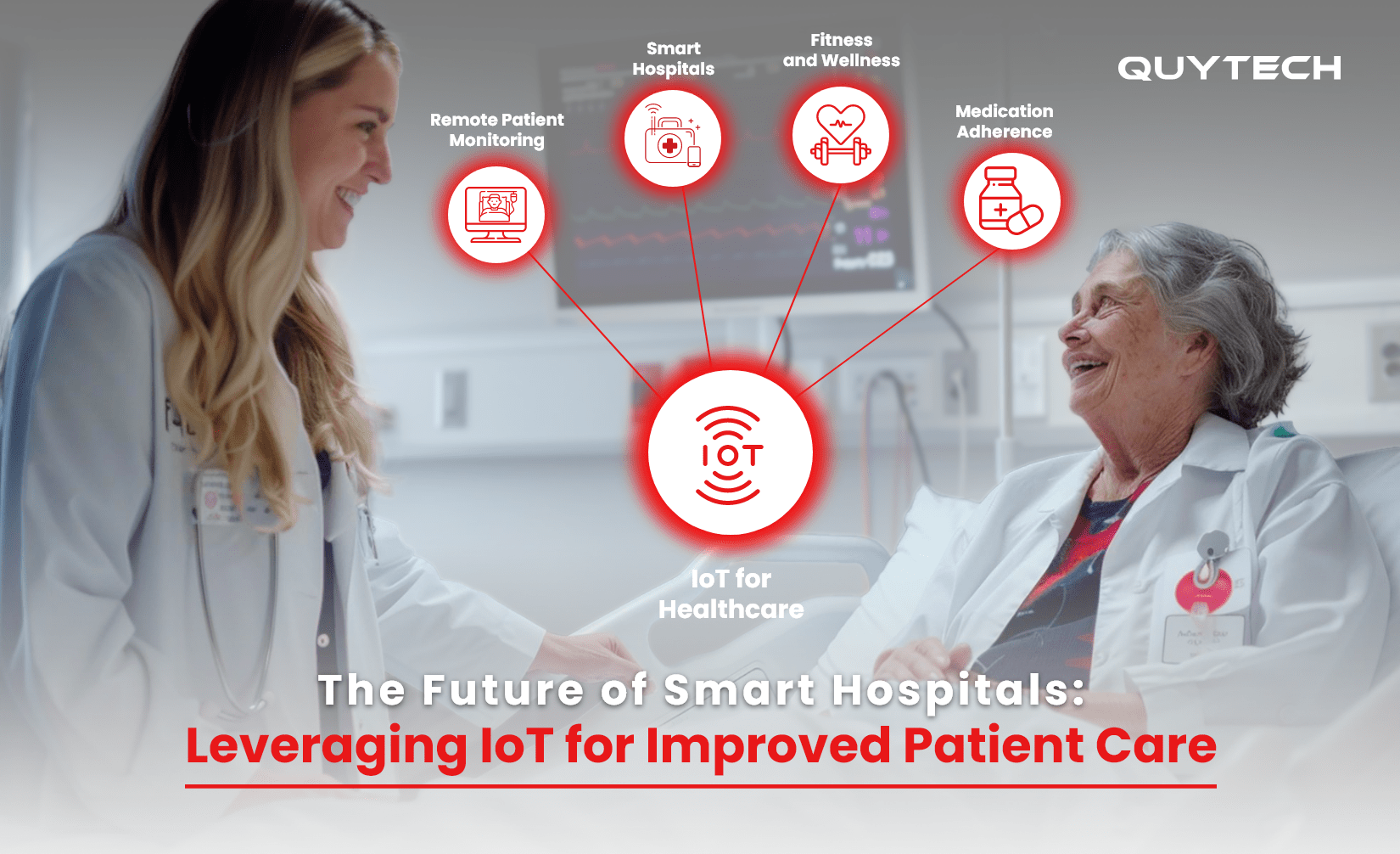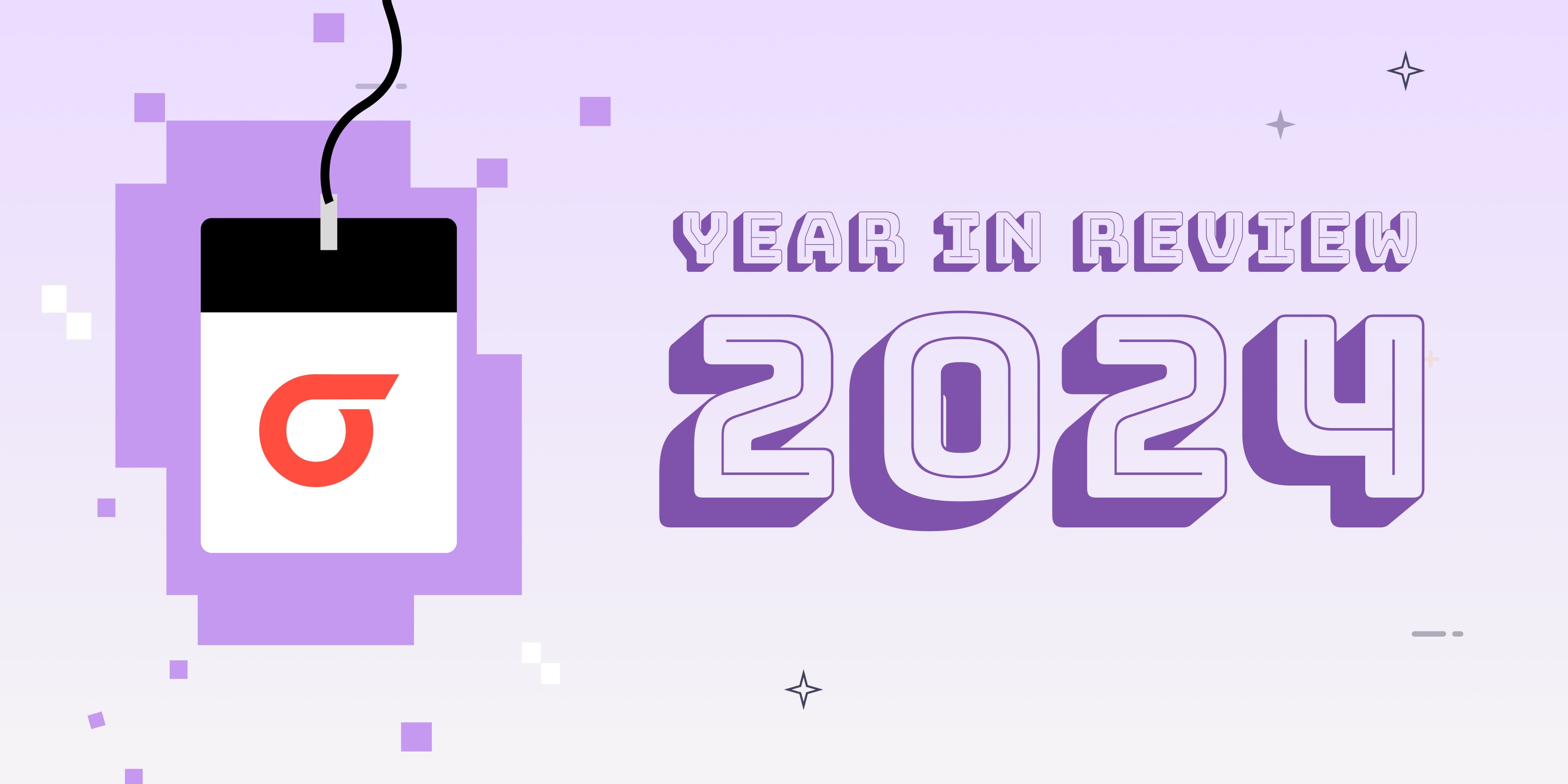Providing improved patient care is the key goal of the healthcare industry. To achieve this, hospitals and healthcare service providers leverage different cutting-edge technologies, which help doctors monitor patients, diagnose diseases, and allow them to offer timely treatment.
The Internet of Things (IoT) is one of those technologies that is playing a key role in enhancing patient care. This is why 83% of hospitals in the USA use IoT-driven devices to monitor patients and manage medical equipment.
But how?
IoT in healthcare allows real-time patient health monitoring & data access that helps with enhancing patient care. In this blog, we have explained the use of IoT for better patient care in detail. So, read till the end to gain some useful insights.
What is the Internet of Things (IoT)?
The Internet of Things, also known as IoT, is a type of network, containing connected devices, appliances, equipment, and more that can exchange data over the Internet.
The devices or appliances in the IoT are embedded with sensors, software, and connectivity that allow them to collect, send, and receive data in real time. The IoT significantly helps in collecting data from various sources and making informed data-based decisions.
How Does the Internet of Things Work to Enhance Patient Care?
In this section, we have explained how the Internet of Things works to improve patient care, in four simple steps.
- Sensors/ Devices
The devices in the IoT (Internet of Things) are equipped with sensors whose role is to collect data from the environment or processes. These sensors measure the data like patient’s body temperature, heart rate, and other health-related metrics.
- Connectivity
Data collected by sensors is transmitted to the local gateway or the cloud via various connectivity options like Wi-Fi, Bluetooth, satellite, or LPWAN (low-power wide area networks).
- Data Processing
After the data reaches the cloud or the central server, it is processed with the help of software or algorithms, such as machine learning, natural language processing, data analytics, or other computational processes, to derive useful information.
- User Interface
In the last stage, the processed data is made available to the end-users through mobile apps, web dashboards, or other visualization tools. This way, users can monitor the data, receive real-time alerts, and even control IoT-driven devices or machines remotely, improving patient care.
Now, let’s talk about the benefits of integrating IoT technology in the healthcare sector.
Benefits of Leveraging IoT in Healthcare For Better Patient Care
There are various benefits of implementing IoT in hospitals, medical facilities, and healthcare centers to deliver enhanced patient treatment and care. Let’s discuss them in detail.
- Remote Patient Monitoring
The major benefit of using the Internet of Things (IoT) is that it allows for remote patient monitoring. Patients wear medical wearable devices to gather data on their vital health signs, like blood pressure, heart rate, body temperature, and more.
The collected data is used by doctors to continuously monitor the patients and detect potential health-related issues in the beginning, leading to timely treatment. Also, IoT allows doctors to constantly monitor multiple patients simultaneously.
- Enhanced Patient Engagement
Another benefit of integrating IoT in the healthcare sector is it enhances patient engagement.
Doctors can track patients’ health metrics using IoT platforms and can communicate with them in real-time using the telehealth services in the IoT mobile app and software.
- Improved Operational Efficiency
Using the IoT, the healthcare industry can automate routine tasks, like patient monitoring, medication management, equipment maintenance, and more, and reduce the workload of the healthcare staff. This leads to improvement in the overall efficiency.
Furthermore, healthcare centers and hospitals can also manage medical equipment and supplies using IoT-powered smart inventory systems.
- Enhanced Patient Safety
IoT also helps healthcare service providers to enhance patient safety. They can use IoT-powered devices to monitor the activities of remote patients and detect events like falls, ensuring their safety.
Moreover, the technology enables healthcare professionals to manage the environment, such as room temperature, ideal for patients remotely.
- Real-Time Data and Analytics
The IoT provides real-time data to the healthcare staff, allowing them to analyze and derive useful insights from it. Further, these insights are used to enhance treatments, patient care, decision-making, modifying healthcare services, and more.
- Reduced Healthcare Costs
Last but not least, the Internet of Things plays a key role in reducing healthcare costs. Using IoT technology, healthcare professionals can monitor patients continuously and provide adequate treatments.
This reduces the chances of hospital readmissions or emergency visits, and hospitals do need to put in extra resources, manpower, and efforts required for the same.
Also, hospitals can use smart IoT-driven solutions to leverage various resources, like medicines, tools, medical equipment, electricity, and more, efficiently and reduce overall operational costs to divert them towards improving patient care.
Other Use Cases of IoT in the Healthcare Sector
The various use cases of the Internet of Things (IoT) in the healthcare industry are as follows.
- Remote Patient Monitoring
In the healthcare industry, IoT-enabled devices are used to continuously monitor patients’ vital health signs and transmit data to healthcare providers.
They analyze these data for real-time patient health tracking and detect potential health issues in the early stage.
- Smart Hospitals
IoT is one of the emerging technologies that is used to transform traditional hospitals into smart hospitals.
The IoT-enabled systems, devices, apps, and software manage various hospital operations, ranging from monitoring environmental conditions in patient rooms to using energy efficiently.
It is also used by healthcare staff to ensure the proper functioning of various healthcare devices and equipment.
- Chronic Disease Management
Using IoT-enabled wearable devices and smart health monitors, healthcare professionals track chronic diseases like diabetes, heart disease, asthma, etc., and provide patients with better treatment before the disease develops and turns out to be life-threatening.
- Medication Adherence
Another use case of IoT in healthcare for improving patient outcomes is medication adherence. IoT-enabled smart pill bottles and medication dispensers allow patients to take medications on time, by sending alerts and reminders on their wearable, such as smartwatches.
- Emergency Response
The Internet of Things technology in wearable devices can detect falls or other emergency situations in elderly or vulnerable patients and transfer that information automatically to alert caregivers or emergency services.
This way, healthcare providers use IoT technology to respond swiftly to emergencies.
- Asset and Inventory Management
In the healthcare industry, IoT is used to manage assets and inventories efficiently. The IoT systems track medical equipment and supplies usage in real-time.
This helps healthcare providers ensure timely availability of supplies and reduce losses or thefts.
- Telemedicine
IoT-networked devices streamline virtual medical consultations, allowing doctors to monitor patients remotely. This way, doctors can provide treatments and patient care without visiting them in person.
- Fitness and Wellness
Wearable fitness trackers monitor physical activity, sleep patterns, and overall health, helping individuals maintain a healthy lifestyle and providing data to healthcare providers.
- Smart Ambulances
IoT technology is also used to equip ambulances to convert them to smart ambulances.
These smart ambulances have IoT-driven devices that transmit patient data to hospitals while it is on the way, giving doctors information and time for better preparation and quicker treatment upon arrival.
- Environmental Monitoring
Many leading hospitals are already leveraging IoT to manage their campus environments.
Sensors powered by the Internet of Things are installed in hospitals that monitor the environment for temperature, humidity, and air quality.
It allows healthcare staff to optimize these environmental conditions for better patient safety and comfort.
- Rehabilitation
IoT also plays a crucial role in physical therapy and rehabilitation processes.
The IoT devices track patient’s data and transfer it to doctors. Doctors analyze these data to calculate progress and optimize rehabilitation routines accordingly.
- Mental Health Monitoring
Similar to physical rehabilitation, IoT (Internet of Things) is also used to monitor the mental health of patients.
Doctors use IoT-driven wearable devices and apps to track activities and gather and monitor physiological and behavioral data to detect mental health issues and provide timely treatment.
This is how smart hospitals use IoT to fulfill various purposes to enhance patient care and transform the healthcare industry.
Step-by-Step Process to Implement IoT in Hospitals
Here is the step-by-step process for implementing IoT (Internet of Things) in hospitals.
Step#1. Assess Requirements and Goals
The first to successfully integrate IoT in a hospital is to determine the specific goals for implementation.
IoT is used for various purposes, i.e. improving remote patient monitoring, managing inventory and supplies, controlling the environment, and more. Thus, you must determine for what purposes you are integrating the IoT.
Furthermore, you must also evaluate the current state of the hospital, its operations, workflows, and areas where IoT can be implemented.
Step#2. Develop a Strategic Plan
The next step is to hire a leading IoT software development company and create a strategic plan to implement IoT in the hospital. You must also consult with healthcare professionals and administrators while making the plan.
While creating the plan, take the timeline, milestones, resource requirements, additional technologies to support IoT, budget, and other factors into consideration.
Step#3. Infrastructure Assessment and Upgrade
Post-plan creation, assess the hospital’s current IT infrastructure and network capabilities.
If they are outdated and do not align with the IoT requirements, you need to upgrade them and expand the network, so that the systems can support IoT devices and streamline data flow.
Step#4. Implement IoT Devices
Implement the IoT devices, and software in the hospital’s systems. Start with the small-scale pilot to test the functioning of IoT devices in a controlled environment.
If the performance report is positive and as per expectations, roll out the IoT-driven devices across the hospital.
Step#5. Data Management and Analytics
You need to establish different protocols for collecting, storing, and managing data you get from the IoT devices.
Moreover, you have to use natural language processing, data analytics, machine learning, and predictive analytics, to derive useful insights required for making informed decisions.
Step#6. Training and Support
You cannot enjoy the benefits of the IoT technology fully, without training your staff on how to use IoT and its applications efficiently. Therefore, train your healthcare staff and your in-house IT personnel to use and maintain IoT devices.
Step#7. Security and Compliance
Implement robust cybersecurity measures to protect patient data and IoT devices from unauthorized access and cyber-attacks.
Also, ensure the IoT devices are compliant with healthcare regulations and standards, such as HIPAA, HITRUST, ISO 27001, and more.
Step#8. Monitor and Optimize
You must regularly monitor the performance of IoT (Internet of Things) devices and systems.
Moreover, you should also leverage user feedback and data to optimize IoT apps and workflows frequently to ensure smooth functioning for a long period.
Step#9. Scale and Expand
Assess the impact of IoT implementation on hospital operations and patient care. Based on the success of the initial deployment, plan to scale and expand IoT applications to other areas of the hospital.
So, this is how you can deploy the Internet of Things (IoT) and associated devices and systems in the hospital to transform it into a smart hospital.
However, there are some factors that you must consider while deploying the IoT in the hospital. Read about those factors in the next section.
Factors to Consider When Integrating the Internet of Things (IoT) in Hospitals
Here are some of the factors that you need to keep in mind when integrating the Internet of Things (IoT) in the hospital.
- Infrastructure Readiness
Before starting the integration process, ensure that the hospital’s network and system infrastructure are upgraded to handle the increased data flow from IoT devices.
Also, you need to get a reliable and uninterrupted power supply for seamless and continuous IoT operations.
- Device Compatibility
You must also select IoT devices that are scalable and compatible with your existing hospital systems.
The devices you choose must integrate with electronic health records (EHR) and other platforms, seamlessly.
- Data Management
Another factor to consider while integrating IoT technology in the hospital is the availability of secure and sufficient data storage solutions that can handle the large volumes of data generated by IoT devices.
Moreover, you need to implement feature-rich data analytics tools to help you get actionable insights from the collected data.
- Security and Privacy
It is crucial to implement strong cybersecurity measures and protocols to safeguard sensitive patient data from unauthorized access, breaches, and cyberattacks.
- Compliance and Standards
You must take care that IoT devices and systems comply with healthcare regulations and standards, like HIPAA, GDPR, and more.
- Ethical Considerations
Last but not least, you must ensure that patients are well-informed and provide consent for the use of IoT devices in their care. Also, there should be transparency with patients and staff regarding the purposes for which the IoT data will be used.
Conclusion
Smart hospitals are the future of the healthcare industry. And this is pretty close. The Internet of Things (IoT) is one of the technologies that are integrated into systems to transform traditional hospitals into smart ones.
In this blog, we explained to you how IoT works, its use cases in the healthcare sector, and a step-by-step process to guide about implementing IoT in the hospital successfully.
So, don’t be at the back of the queue! Act now to implement IoT in your hospital or medical facility and transform patient care. Likewise, if you need professionals to do this job for you, feel free to get in touch with Quytech.
We are the leading IoT software development company that has transformed numerous conventional healthcare facilities into smart hospitals by implementing high-end technologies like IoT, AI, Blockchain, and more. Visit our website today for more information.
Frequently Asked Questions
Here are some FAQs related to the implementation of IoT in hospitals.
The Internet of Things, also known as IoT, is a type of network that has connected devices, appliances, equipment, and more, that can exchange data over the Internet, in real-time.
Smart hospitals are hospitals or medical facilities that are equipped with cutting-edge technologies like artificial intelligence (AI), blockchain, the Internet of Things (IoT), Big Data analytics, and more, to provide better and more accurate patient care.
IoT helps in enhancing patient care by providing real-time data collected from various IoT devices and apps to doctors. Doctors use these data to analyze the condition of the patients and detect potential diseases, for timely intervention.
To implement IoT in the hospital successfully, follow these steps:
Step#1. Assess Requirements and Goals
Step#2. Develop a Strategic Plan
Step#3. Infrastructure Assessment and Upgrade
Step#4. Implement IoT Devices
Step#5. Data Management and Analytics
Step#6. Training and Support
Step#7. Security and Compliance
Step#8. Monitor and Optimize
Step#9. Scale and Expand
You can read our blog “The Future of Smart Hospitals: Leveraging IoT for Improved Patient Outcomes” to learn about these steps in detail.
Post Views: 21




















Discussion about this post